My Story
Below: Me finishing my first one the 1984 Festival City Marathon.

Introduction to Marathon Running
My Story
Below: Me finishing my first one the 1984 Festival City Marathon.

My time in long distance running seemed to go on forever especially the training for my first Marathon but really very short in the context of a lifetime. Nine months of fitness preparation, then just 5 years from the first to the last Marathon.
It all started from watching telecasts of Aussie sports hero Robert de Castella winning the 1982 Commonwealth Games
Marathon, 1983 Rotterdam Marathon (9 April), and 1983 World Marathon Championship in Helsinki (14 August).
Meanwhile in May 1983 Cliff Young won the inaugural 1,000 km Sydney-Melbourne
ultra-marathon at the age of 61 !
At the end of the Corporate Cup series in early November 1983, the
S.A. Road Runners Club (SARRC)
was distributing free copies of its monthly glossy magazine South Australia RUNNING.
The club seemed to be generally interesting, but the really fascinating part was the complete
results of its recent Festival City Marathon the last one on the Gawler to Adelaide route.
A magazine page that still endures in my mind more than 20 years
later, is this fascinating study of desperation :
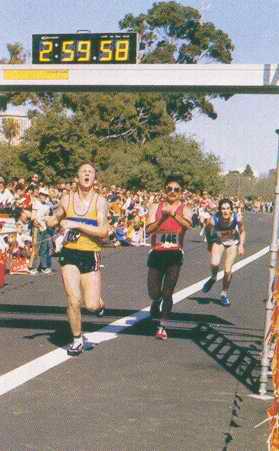 2:59:58
2:59:58Two metres to go, legs collapsing, a sub-three-hour finish seems impossible for the third runner. |
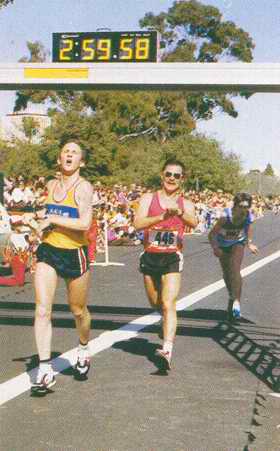 2:59:58
2:59:58One step is like a mile. |
|
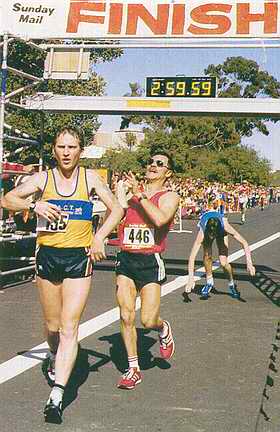 2:59:59
2:59:59Determination reaps its rewards a personal victory for all three runners. |
Sub 3 hrs. The runners are |
The S.A. Road Runners Club had initially grown out of the Distance Runners' Club of South Australia,
organisers of the inaugural (1979) Festival City
Marathon, so its main plan centred around the Marathon in August, with a progression of distances over a 39 week
period based on the "Honolulu Plan" although people with other aspirations were also well catered for. Right from
the beginning, the emphasis was upon fun exercise and social interaction. Its slogans were
"Australia's Largest Runners Club" and "Australia's Friendliest Marathon." Good practical
advice went like this "If you're running too fast to talk, you're
running too fast." I'm not sure why, but talking really does enable one to run longer distances before fatigue sets
in. Perhaps something to do with relaxed muscles, so you don't have opposed muscle groups fighting each other (as
always occurs when you're stressed out).
There was never any desire for SARRC to affiliate with the Amateur Athletic Association of S.A., although on 1 or 2
occasions in the mid-1980s, the Festival City Marathon was run concurrently with AAASA's State Marathon Championship.
This was mostly to avoid duplication of organising effort and expense, but the SARRC organisers also sought to improve their
event's status and number of entrants. The AAASA, being competitive in nature, preferred a flat (fast) course which I
believe they had at West Lakes. SARRC, being more of a social club, preferred a scenic route that happened to include
a "Heartbreak Hill" at 25 km, so the combined Marathons didn't last long.
SARRC's "Training Log" was an important aid, and showed good forward planning
In December I saw Alan Cooper in the crowd on a Sunday morning. We recognised each other from the S.A. Tourers
Motorcycle Club during the late 1970s to early 1980s. Alan said that he preferred starting at 7 am instead of 8 am
during summer to avoid the heat, and invited me to join him and his friends Con Kiosses, Alan Hanlon and Avril Hill.
As we began a 10.2 km River Run (the club's prescribed run for the day), I saw some other runners going in a different
direction, and asked Alan "Where are they going?" "Probably an old Half Marathon course" was his reply.
I couldn't comprehend how anybody would be able to run 21.1 km already! By the end of January, I had begun to run
21.1 km on a regular basis.
I was able to keep up with the little group on the first few runs (which were shorter), but as the weeks rolled on, I found myself lagging
a couple of hundred metres behind them after only 5 km not good for morale. I also missed Bruce's motivating speech
just before 8 am, but the earlier start allowed me to get to church by 11 am.
A special feature of the club's Marathon training plan was an evening seminar each month in a lecture theatre at
the Flinders Medical Centre. Topics were everything a first-time participant needs to know, ranging from health maintenance
to traffic control (with police Sergeant John Shepherd).
The club was also proud of its AIMS membership (see the top of this page) especially the certification of the Marathon
course distance. Everybody running in the biggest event of their lifetime wants to be sure that they achieved it not
just 99.7% of a Marathon as happened at the New
York City Marathon in 1981, where Alberto Salazar was credited with a "world best" performance
until the course was re-measured, 148 yards short!
With the need for all aspiring marathoners to train several times each week, the club approved the formation of a couple of mid-week groups. I joined the group established by Stella Emberson at the Gilles Street Language Centre (primary school) in Adelaide. Meeting at 5:30 pm on Wednesdays, the group quickly became an enthusiastic mutual support community, and we improved together.
On 1st April I ran my first City-Port Fun Run (15 km) in 63 minutes, and on 6th May I ran my first Greenbelt Half Marathon in the satisfying time of 1:33:08 a few minutes faster than I'd expected. It didn't make the training less painful, but at least I could see a clear possibility for the Marathon in August. A bit of a scare during June "shinsplints" in the right shin, due to incorrect footwear and overtraining. While on leave from work, I had extra time for training, so I increased my training distance during one week to 102 km, up from around 70 km in the previous weeks. At that time, my Brooks Super Villanova shoes had almost worn out, so I bought a pair of New Balance 550 shoes but they didn't quite suit me. Fortunately, the remedy was simple tame the distance back to 70 km/week, and get a new pair of Brooks shoes. (Brooks Super Villanova were the cheapest of the respectable brand shoes, because they didn't try to fix problems that I don't have: over-pronation and over-supination).
Click here to read the details of my 1984 Training Log pictured above (36 KB).
The new Marathon course was very picturesque mostly in and around the "greenbelt" of the Adelaide parklands.
Before the big day, I'd trained so often on every segment of the course that I'd become totally familiar with it and very
bored by the scenery. All of this training had built up my speed and endurance (an equal mix of fitness and movement
efficiency), and an exact awareness of what speed would be sustainable. Careful calculations revealed that, at 5:30/km,
I should be able to complete the distance in 3 hours 52 minutes safely under my self-imposed 4 hour embarrassment mark.
I asked Dad to be my pit crew for the day. He seemed to be less than enthusiastic, but agreed to have my spare shoes
and socks at 3 or 4 pre-arranged points, in case of rain causing wet, heavy shoes.
After the starter's gun sounded, I found myself merrily chatting with my Sunday training partners Con Kiosses and Alan Hanlon,
for 14 km in 70 minutes. Too fast! My little book "Training For Your First Marathon" by Dr. Jack Scaff
(a description of the Honolulu Plan) had warned against this.
I was running 10% faster than schedule, so I let Con & Alan go on ahead. At 24 km (by the North Adelaide railway
station) I found one of my Wednesday evening training partners sitting on the ground, using a guide post as a backrest.
One leg was in a plaster cast. "What happened to you, Chris?" "I broke my leg skiing." (That momentary encounter
caused me to turn down a couple of invitations to go skiing over the next few years). I was then to encounter the typical
Marathon experiences all is well until about 32 km when the legs start to feel very slightly tight, and around 37-38 km
the legs start refusing to play the game. This is very painful, but in a very different way to the lactic acid
experiences of short distance runners. The brain also fades badly (so it's vital to runner safety that Marathons are held on traffic-free
roads), but the thought of just stopping 4km from the finish line (and no finisher's medallion) is the big stick that keeps the
motivation going. Then at 42 km with just 200 metres left, you turn the corner (or go under the Adelaide Bridge,
depending on the particular finish area), catch sight of the Finish Line and a rush of adrenaline totally overrules the
tired muscles and mind a sprint finish.


Into 1985, and I was looking towards racing the short distances at 4 minutes/km (15 km/h). That meant (hopefully) completing the 15 km City to Port Fun Run in 60 minutes. On 31st March, a couple of my friends showed up to cheer for me along the way. It was a rather warm day, and I started to feel faint around 11 km. Some guy had a bucket half full of water, so I grabbed it from him and inverted it over my head. That cooled my head a bit, but it also drenched my left shoe and sock, making them heavy. My official finishing time was 60:42 (although 61:00 on my watch). Not only did I fail to achieve 60 minutes, but my health very soon fell away probably Chronic Fatigue Syndrome several years before that phrase was first used. Unable to do anything more than short training runs, I tried participating in Roger Pederick's speed training sessions on Saturday mornings, but my condition became worse. The only way I could participate in a race was to be a bicycle marshal in the 1985 Festival City Marathon ensuring that the 2 visiting elite women (Iris Cook from Victoria and Winnie Ng from Hong Kong) didn't take a wrong turn. The women's field commenced several minutes before the wheelchairs and men, so they were out on their own until the wheelies caught up at the return to the top of Anzac Highway (20 km). I had a 15 second chat with Robert Turner (the eventual wheelie winner) as he went past his speed down Anzac Highway had been 28 km/h, but only 14 km/h on the way back up.
While I longed for a return to good health, I briefly contemplated the theoretical possibilities for a zealous marathoner. SARRC offered a special package tour to the London Marathon, including exemption from the normal pre-requisite level of marathon achievement. The advertised attraction was to be in one of the biggest marathon fields ever assembled. I also saw a promotion for the event from Marathon to Athens, billed as "the original run" (presumably retracing the 1896 Olympic Marathon route). I didn't have the money to throw around for these indulgences, so I never pursued them.
During December my strength suddenly returned, and I wanted to celebrate by getting fit again. It was also announced that the 1986 Festival City Marathon would be an official Jubilee 150 event (to celebrate 150 years since the state was proclaimed a British colony). As time went on, it became evident that many hundreds of lapsed runners were making a comeback for the event. This artificial "high" caused an illusion that long distance running would remain popular for years to come. In reality, biathlons and triathlons were already topics of discussion amongst many runners who struggled to maintain enthusiasm for 7-10 hours of monotonous running training every week. (SARRC membership for 1986 was 2605, dropping to 1636 in 1987).
A slight complication entered the scene very early in 1986, when I registered with SARRC as a
"Trainee Start-Running Instructor." Having obtained a lot of encouragement from the club, I thought I should put
something back into it. The year-long traineeship started with a weekend camp where we learnt a lot of useful stuff
(e.g. stretching exercises) that I wished I'd known 2 years earlier and would have learnt, if I'd gone to those
Start Running classes (for beginners) instead of going straight onto the River Runs late in 1983.
With a 7 am start on Sundays, I was able to do a 10 km run and be back in time for the Start Running
classes at 8 am keenly observing how the real Instructors led their groups.
Despite the short Sunday runs, I gradually built up my weekly training distances, peaking at
100 km/week for 10 weeks before the Marathon. (Click
here to see my 1986 Training Log). Then due reward for my hard work 3:21:53 a PB
(personal best) by 13 minutes! This lent a bit of support to my earlier theory that the quickest marathons aren't run
until 31-32 years of age.
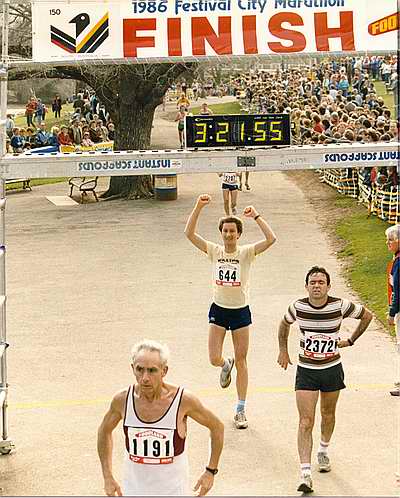
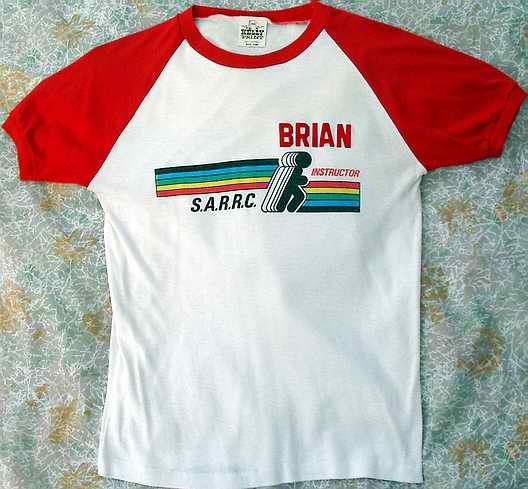
By comparison, 1987 was a year of relative rest. I kept up a bit of training, but it was very relaxed and not
recorded for distance. In March, one of the guys at work, Roger Spence, challenged me to a showdown in the SARRC 10 km
race. Initially I declined on the grounds that I was no longer race-fit, and Roger was a faster runner over short
distances despite being 10 years older. After days of harrassment, I agreed subject to having sole bragging rights.
Roger cleared off like a rabbit at the start (in accordance with his rampant lack of calculation and self-control), and I
could no longer see him after 2 km. After 8 km I caught sight of a slow-looking Roger expectantly looking behind for
my approach. I passed him in the last kilometre, having saved enough energy for a surge. Brian wins (and brags
at work). That was typical of how I went about training and racing maintain an awareness of my capability, and stick
on or under that speed. On the road, my feel for consistent speed had developed to the point where I could arrive at
the kilometre markers no more than 2 seconds early or late.
My first Start Running class failed when all participants ceased attending for various reasons. Ted Trojanowski
had invented "Advanced Beginners" as a support group for those who had completed Start Running, but wanted to progress
further. I decided to help them for a term.
Two 3-month seasons of Indoor Cricket with work mates were made more enjoyable by being moderately fit. I treated the
Festival City Marathon as a fun run knowing full well how to do it. I adjusted my race schedule to compensate for
the lack of extensive training, so the outcome (3:33:51) was an entirely satisfying time, yet I was still comfortable at the
finish (within the context of the usual pains). In the photo below, I've just lept up and punched the Finish banner
with my fist.

The year ended with me apparently suffering from the effects of a virus for 3 months. Playing my only season for the Prospect Tennis Club, I went winless in singles until the mid-summer break (and for the duration of the virus). One of my team mates was a well-mannered 13 year old named Nick Holland (who went on to become a famous AFL footballer with Hawthorn and S.A.). An already-famous opponent with Klemzig was Darren Jarman (North Adelaide Football Club, later Hawthorn then Adelaide).
Very early in January 1988, the virus disappeared and I became determined to build up fitness for the 2nd half of the
tennis season. Back to the only fitness training I knew the LSD scene (long, slow distance) strictly observing the
10% rule (never increase training distance or speed by more that 10% over the previous week).
The fitness improvements were impressive I
didn't lose any singles sets at tennis after the mid-summer break. Of course the tennis season ended in March, but why
quit running when I'm doing so well? Better keep going and get some good race results. I took the 10% rule to its
limit and finished the Marathon preparation with 12 weeks @ 120 km/week. Not only were my weekly aggregate distances
large, but I made a point of doing a long slow one every Saturday the longest being 45 km. Late in 1984, one
of the older experienced runners had advised me that the best Marathon times come only from doing a 35+ km run each week.
A week of rest before the race, and I thought I had a serious
chance of breaking the 3 hour mark. (Remember the 1983 magazine photo sequence above?)
On the big day I wasn't quite able to achieve it, arriving halfway a minute late,
and 7 minutes 13 seconds late at the full distance but still a PB by over 14 minutes. A top 12 percentile placing in
a field of dedicated runners, and I beat the 4th placed woman by well over 2 minutes although one should honestly say that
it was a slow year for the women.
The irony of my good performance was that, with the course being a series of loops, I was
able to hear the crowd and public address system cheer the winner while I was running through
Botanic Park (Plane Tree Drive) still having 10 km left to run.

For the Melbourne Marathon, all I had to do was knock another 7:13 off my PB. In this "all or nothing" attack on the 3 hour mark, I drove my car across to Melbourne, with my brother Wayne and his first fiancee Becky as my pit crew. I even brought rainwater from home, for drinking during the Marathon. On the evening before the race, I drove my car along the course to see whether in 4 years I'd forgotten any annoying features. No problems, I thought, until I fronted up for the start. There was a huge sea of runners it took me 4 minutes to cross the Start line, and several more minutes to achieve race pace. Then there was a strong head wind, but I had to go for my 3 hours objective that was the whole reason for me being there. By halfway, I hadn't recovered any of those 4 minutes lost in the crowd at the start. By 28 km, the head wind had really knocked the stuffing out of me, and a couple of km later I "hit the wall" as they say just stood on the footpath, unable to keep running. I knew it was over for me, but I wondered how to get back to the Finish area where Wayne would have my car waiting for me. After a minute or so, I began walking slowly for a while, then up to a slow trot, and I passed a man handing out jelly beans. Perhaps I had a shortage of blood sugar, so I took a handful of jelly beans and ate them all slowly. After a short while I was back up to a fairly decent running speed, and eventually finished in the semi-respectable time of 3:23:08, so I estimate that "hitting the wall" cost me 15 to 17 minutes. No regrets; I tried, but wasn't good enough to break the 3 hour mark.
Below: No photo; just a certificate for the 1988 Melbourne Marathon.
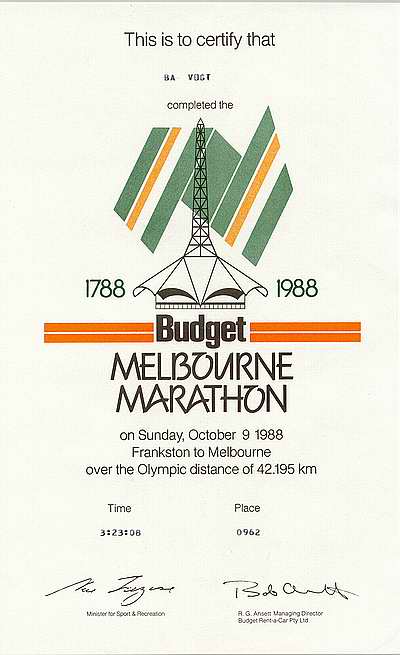
As you can see, Big M (a brand of milk) was no longer the major sponsor.
My friends thought Big M had been the perfect name for the Melbourne Marathon.
Some thought this one should have been the "Big A" Melbourne Marathon,
named after Bob Ansett (owner of Budget Rent-a-Car). ![]() They were later proved correct, as Budget went bankrupt within 2 years after this.
They were later proved correct, as Budget went bankrupt within 2 years after this.
Late in the year I returned to Roger Pederick's speed training sessions on Saturday mornings, as a replacement for the longer training runs. As a result, I noticed that my speed began to diminish(!) slightly, and training became increasingly difficult to sustain. I was glad to quit the training ritual on 31st December, but was proud of what I had achieved. My total amount of running (training + racing) for the 1988 calendar year was 4,706 km at an average of 90.5 km/week.
For 1989, it was a huge relief to abandon the hard training. I did light training runs if and when I felt like it.
More important to me by then were the Start Running classes and Advanced Beginners group on Sunday mornings. The groups
I led were making very good progress, so I was satisfied with being able to put something back into the club.
Just 6 weeks before the Festival City Marathon, I decided to do it once more as a fun run, like in 1987.
6 weeks of training @ only 60 km/week shouldn't lead to any great expectations, but I achieved the very satisfying time of
3:24:14 on 13th August. (That's only 2 min. 19 sec. slower than my 1986 result from full training).

My severe fatigue lasted for 21 months (until May 1991), by which time I had put on a lot of weight (something which was
absolutely impossible before). In an effort to regain some fitness, I persisted with trying to play tennis.
The 1991-92 summer season was quite successful and enjoyable, although I missed playing in my team's grand final appearance
due to a late change in match programming which clashed with my interstate holiday.
On 10th November 1992 at 6:10 pm, I suddenly slipped over at tennis practice, fracturing my right
patella.
For many years, painful swelling set in after running just 1-2 km.
In mid-2004 a physiotherapist suggested that I use "Glucosamine with Chondroitin."
It has helped a lot to reduce the clunky action of that patella and consequent swelling.
Training runs for tennis fitness became possible again (with a longest distance of 15 km), but by
the end of February 2009 old age had clearly caught up with me, and I permanently retired from
tennis competition.
At the end of July 2010 I was diagnosed with
atrial fibrillation
and paroxysmal
atrial tachycardia.
Training runs are ruled out, but my daily exercise includes a 4.6 km walk with a fastest average speed
of 7.50 km/h.
One thing still seems certain I will never run another Marathon.
Closing Comments
After all these years, I'm disappointed to see that the Adelaide Festival City Marathon has faded from public view, and that it is no longer a member of AIMS. The harsh reality is that Marathon running has returned to being an obscure sport locally, so sponsorship money is scarce, and it's not worth paying the AIMS membership fee and expenses for a course certifier from interstate (think in terms of adding $20 to the entry fee in a small field of runners). Neither is it worth closing a few of Adelaide's arterial roads for a couple of hours each, so the Marathon is effectively relegated to pedestrian paths and back streets out of sight, out of mind as far as the public is concerned. Perhaps in another 20-30 years there might be another wave of public fascination with Marathons, especially if Australia gets a new version of Robert de Castella. "Deek" wasn't our first Marathon prodigy, and hopefully he won't be our last. What was different in 1982: live TV coverage from a bunch of mobile cameras was still novel new technology, and it captured public attention. Now it's a routine method, used for everything from the Tour de France to OJ Simpson car chases.
"Deek" was once quoted as saying that he was full of admiration for the slower runners, on the basis that he only had to
do his best for a bit more than 2 hours, and the race was over. Slower runners had to give it everything for 4+ hours,
which (it seemed to him) was a more severe test of endurance. Good point.
Another quote from him: "Running is not a penance" (in reply to the old sports coach proverb "No pain, no gain").
Running should be fun. If you're always in pain, slow down a bit and recover from your injuries.
I discovered fairly early that cycling is good for post-race recovery. It uses distinctly different muscles to those used for running (so the injuries are not made worse), and the resultant increase in blood flow to the injured muscles helps in the healing process.
Spending so much time on the streets and in the company of other runners, one can reasonably
expect to see a few "interesting" things happen. In 1985, the Wednesday evening group ran up
Hackney Road and around Fitzroy Terrace at the top of North Adelaide. As we neared the Adelaide
Aquatic Centre, most of us stayed on the footpath within 2 metres of the kerb except Rodney Beck
who didn't know there was a 2-strand wire fence that finished another 2 metres to our left.
Becky bounced off the fence at 12 km/h in the dark, and wasn't injured at all.
A less amusing incident occurred in the early evening of Christmas Eve, 1986. I'd almost
finished a training run, going north along Braund Road, Prospect, when I came to a stationary car
between Marian Place and Castle Avenue. Its engine was being spun to around 6,000 rpm in the
way that first-time drivers sometimes abuse them while trying to learn throttle control. This car wasn't wearing L plates, and I'd bet big
money that the driver was unlicensed. There seemed to be a passenger issuing instructions.
I was very apprehensive about running past a car that
could suddenly be out of control, so I got on with it quickly. Safely out of range, I heard the
engine reach valve-bounce speed, quickly followed by the howl of tyres being asked to do too much,
and then a crash. After a few more seconds, there was a woman's loud scream. It took me 2
minutes to go back (400 metres at training pace), and I found a small group of neighbours already
gathered around the crash scene in 76 Braund Road. The car had gone through the side fence
at the corner of Castle Avenue, and came to rest above the fish pond in the front yard. A
young woman remaining with the car responded to someone's question: "I'm the owner. The
driver panicked and ran away." Nobody needed my assistance, so I ran away too albeit with
a great deal more decorum than the driver.
Other road runners often seen while out on training runs:
Judge Robin Millhouse
of the state Supreme Court, and former state Attorney General. Normally seen without a shirt/singlet.
State Premier, John Bannon
was a SARRC member often seen at the large 8 am gathering in North Adelaide on Sundays. Some
people said his running posture looked like he'd been stabbed in the back with a dagger.
True, but he was a sub-3 hour finisher in all Festival City Marathons from 1979 to 1986, then a narrow miss in 1987
due to heavy work commitments which restricted his training to 40 km/week. Presenting the Marathon awards
in the adjacent Festival Centre later that day, Mr. Bannon recalled a training
run on a cold, wet evening that oppressed his enthusiasm. "A kindred spirit!" he thought to
himself as another runner approached. "What about that property tax you bludger!" said the mysterious runner as he went past.
(The state govt. subsequently abandoned its proposal to introduce a property tax, until the Emergency
Services Levy was introduced over a decade later). In general, runners set politics aside and let
Mr. Bannon enjoy his recreation time.
| Event | Time | Comments |
| 1984 Festival City Marathon | 3:51:44 | First try, not really knowing what to expect. |
| 1984 Melbourne Marathon | 3:34:54 | New PB. Very happy with the improvements. |
| 1986 Festival City Marathon | 3:21:53 | New PB. Fair reward for plenty of training. |
| 1987 Festival City Marathon | 3:33:51 | Only a fun run; very relaxed training. |
| 1988 Festival City Marathon | 3:07:13 | New PB. Fair reward for huge amount of training. |
| 1988 Melbourne Marathon | 3:23:08 | 3 hours or bust. I "hit the wall" before 30 km. |
| 1989 Festival City Marathon | 3:24:14 | Only a fun run, entered as an afterthought. |
| 1984 Walk Against Want (30 km) | 2:25:00 | Community Aid Abroad (Oxfam) fundraiser |
| 1986 SARRC Glenelg 30 km race | 2:10:35 | Slower than C/wealth Games 30 km Walk winner! |
| 1988 SARRC Glenelg 30 km race | 2:05:42 | New PB and very pleased. |
| 1984 Greenbelt ½ Marathon | 1:33:08 | First try. Very satisfied. |
| 1986 Greenbelt ½ Marathon | 1:29:24 | New PB. |
| 1988 Greenbelt ½ Marathon | 1:26:25 | New PB. |
| 1984 City-Port Fun Run (15 km) | 1:03:00 | My first race longer than 11.1 km. |
| 1985 City-Port Fun Run (15 km) | 1:00:42 | New PB, but missed 60 minutes. |
| 1987 City-Port Fun Run (15 km) | 1:31:25 | Pacer for Advanced Beginners group; not racing. |
| 1986 City to Surf (14 km, Sydney) | 1:04:51 | Not risking injury; Marathon 3 weeks later. |
| 1979 City-Bay (11.1 km) | 1:05:05 | My first race, no training runs, no idea at all. |
| 1981 City-Bay (11.1 km) | 0:59:46 | |
| 1982 City-Bay (11.1 km) | 0:54:37 | |
| 1983 City-Bay (11.1 km) | 0:53:44 | |
| 1988 City-Bay (12 km) | 0:45:13 | |
| 1989 City-Bay (12 km) | 0:50:29 | Not recovered from the 'flu. Severe consequences. |
| River Run 10.2 km 1983 Dec. 4 | 46:51 | |
| River Run 10.2 km 1983 Dec. 18 | 46:31 | |
| River Run 10.2 km 1984 Jan. 1 | 45:56 | |
| River Run 10.2 km 1984 Jan. 15 | 48:48 | |
| 1986 SARRC 10 km race | 1:01:16 | Pacer for Start Running group; not racing. |
| 1987 SARRC 10 km race | 0:39:48 | 1-on-1 match race against Roger I win. |
| 1989 SARRC 10 km race | 0:39:51 | Disappointed to miss a PB by 3 sec. |
| 1984 Golden Jubilee Mile | 0:05:29 | AAASA organised event, temp. around 35°C |
National Running Week
in and around Thredbo Alpine Village, in the
Kosciuszko National Park.
The Kosciusko Classic is Australia's highest race from the start line, run up to the summit of Mount Kosciusko
(Australia's highest point at 2,228 metres above sea level), touch Strzelecki's name on the plaque, then run back to the
start/finish line. The 1986 course was upon the elevated steel grid walkway (photo); a couple of runners tripped over at top
speed on the way down, and looked like victims of a feral carrot grater. As a result of severe impact damage to the
walkway (and actual long-term destruction in places), organiser Brian Lenton was instructed by the park ranger to find
another course for 1987.
The Crackenback Challenge is Australia's steepest race on the path under the Crackenback chairlift, 2,000 metres
long, 550 metres altitude increase.
| 1986 Kosciusko Classic (12.8 km) | 1:07:04 | From Crackenback to the summit & back. |
| 1987 Kosciusko Classic | 1:05:51 | Route and distance not recorded. |
| 1989 Kosciusko Classic (10 km) | 0:45:27 | From Snowy River Bridge to the summit & back. |
| 1986 Thredbo Fun Run (9 km) | 0:39:28 | Hilly course through and around the village. |
| 1987 Thredbo Fun Run (9 km) | 0:40:39 | |
| 1989 Ron Vines 6 km Fun Run | 0:24:04 | Loop in the village. |
| 1989 Pharmacy 6 km Fun Run | 0:24:44 | Loop in the village. |
| 1989 Crackenback Challenge | 0:32:09 | Almost like running up stairs, but without steps. |